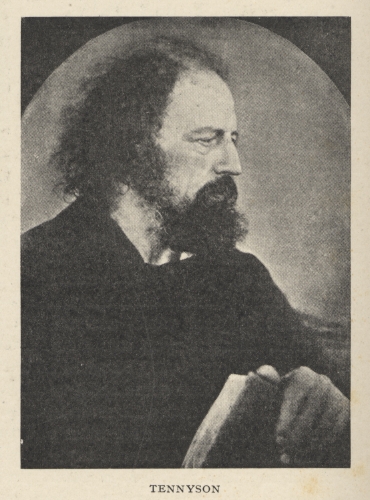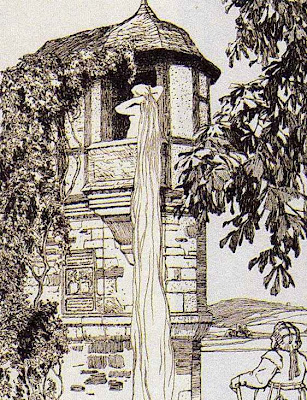The Portrayal of the Cloistered Victorian Woman
Shabnam Yusufzai and Sue Chun
1372
|
The Victorian era held specific ideological assumptions regarding the roles and characteristics of women. The ideal Victorian woman was considered to be clean and pure, completely detached from sexual connotations. Their main role consisted of domestic duties that took place within the private space of their household. Women were isolated from the outside world – a world that was socially and politically considered a masculine realm. While men actively participated in the public, women were unable to engage in the outside world because it would taint their feminine virtue. This ideological notion of the Victorian woman is widely portrayed within various Victorian works. Alfred Lord Tennyson’s 1842 poem, “The Lady of Shalott”@Alfred Lord Tennyson. "The Lady of Shalott." 30 Nov. 2004. The Victorian Web. 24 Mar. 2011., illustrates the stark divide between the gender roles apportioned to the men and women of the Victorian era through an Arthurian context. Tennyson makes use of the interior and exterior worlds to emphasize the notion of the cloistered woman. The tragic themes presented in Tennyson’s “The Lady of Shalott” fascinated the Pre-Raphaelite artists, and as a result, there have been over fifty illustrations of the Shalottian figure created within the second half of the nineteenth century. One of the most famous depictions of Tennyson’s poem is William Holman Hunt’s 1905 oil painting, Lady of Shalott. Although completed in 1905, Hunt had worked on this specific representation of the Lady for over four decades. |
Both the poem and painting reinforce the notion of the isolated
Victorian woman. Hunt’s illustration however, presents the lady
physically entangled within the threads of her tapestry, which is a
moment visibly absent from Tennyson’s poem. While Tennyson’s Lady
reinforces the Victorian society’s conception of the ideal woman, Hunt’s
Lady subverts and violates her prescriptive female role. Tennyson
disapproved of Hunt’s illustration, and regarded it to be an inaccurate
representation of his poem.
Tennyson: Why is the Lady’s “hair wildly tossed about as if by a
tornado?” and why does the web “wind round and round
her like the threads of a cocoon?”
Hunt: “I had wished to convey the idea of the threatened fatality by reversing the ordinary peace of the room and of the lady herself.”
Tennyson: “The illustrator should always adhere to the words of the poet!”
Hunt: “I had wished to convey the idea of the threatened fatality by reversing the ordinary peace of the room and of the lady herself.”
Tennyson: “The illustrator should always adhere to the words of the poet!”
Alfred Lord Tennyson’s poem “The Lady of Shalott” was first published in 1833 and originally consisted of 20 stanzas. However, Tennyson’s 1842 revision of the poem now has 19 stanzas and was considered by most critics as a much more improved version of the poem.@Alfred Lord Tennyson. "The Lady of Shalott." 30 Nov. 2004. The Victorian Web. 24 Mar. 2011. Although the poem is titled “The Lady of Shalott”, Tennyson emphasizes more on the setting of the poem and focuses on the Lady’s interior and exterior surroundings rather than the Lady herself. Tennyson shows the Lady’s isolation through her physical situation by contrasting the active exterior world of Camelot to the “four gray walls and four gray towers” that confines her. The cloistered Victorian woman is represented as a passive figure that has accepted her private space where she only engages in the domestic work of weaving.
“She weaves by night and day/a magic web with colours gay”. (II.45)
Tennyson’s “The Lady of Shalott” reflects the ideologies of the 19th century in which Victorian men and women were divided by public and private space. For example, the Lady’s tower is a domestic domain that allows her to weave, which is connected to femininity. On the other hand, the public realm of Camelot is dominated by “bold Sir Lancelot”, which associates the exterior world with masculinity. Although the poem takes place in feudal settings, it is still based upon Victorian England’s society and its principals, values, and patriarchal norms.@Meg Mariotti. "The Lady of Shalott: Pre-Raphaelite Attitude Toward Women in Society." 2004. The Victorian Web. 24 Mar. 2011. “The Lady of Shalott” is portrayed as pure, proper, and domesticated figure that fits the ideal expectations of Victorian women in the 19th century. Similar to “The Lady of Shalott”, Victorian women had to accept their domestic duties by not engaging in the public realm that belonged to men. Both the Lady’s cloistered position, gender, and occupation shows Tennyson’s construction of the ideal Victorian woman and the role she must serve in society.
“She weaves by night and day/a magic web with colours gay”. (II.45)
Tennyson’s “The Lady of Shalott” reflects the ideologies of the 19th century in which Victorian men and women were divided by public and private space. For example, the Lady’s tower is a domestic domain that allows her to weave, which is connected to femininity. On the other hand, the public realm of Camelot is dominated by “bold Sir Lancelot”, which associates the exterior world with masculinity. Although the poem takes place in feudal settings, it is still based upon Victorian England’s society and its principals, values, and patriarchal norms.@Meg Mariotti. "The Lady of Shalott: Pre-Raphaelite Attitude Toward Women in Society." 2004. The Victorian Web. 24 Mar. 2011. “The Lady of Shalott” is portrayed as pure, proper, and domesticated figure that fits the ideal expectations of Victorian women in the 19th century. Similar to “The Lady of Shalott”, Victorian women had to accept their domestic duties by not engaging in the public realm that belonged to men. Both the Lady’s cloistered position, gender, and occupation shows Tennyson’s construction of the ideal Victorian woman and the role she must serve in society.
The representation of the cloistered woman in Tennyson’s “The Lady of Shalott” is a universal theme that has been embedded in literature since the conception of fairytales. Tennyson uses fairytale motifs in his poem, which include the portrayal of a fair maiden who is trapped in the tower and is endangered by a curse. This iconic image has now been coined as the “Rapunzel Syndrome” by author Margaret Atwood. One of the key traits of the Rapunzel Syndrome is that the damsel in distress must learn to cope with her cloistered position and internally conform to the societal constraints in which she is situated in. This very description applies to “The Lady of Shalott”, seeing as she does not question or deny her domestic duties of weaving but learns to suppress her emotions in order to fit the ideal feminine role. In Tennyson’s portrayal of the cloistered woman, he does not provide any helpful options for the Lady that will lead to her freedom. For example, the embowered woman is confined within her tower but her escape also leads to her death. "The broadest, most general irony of the poem is that the Lady simply exchanges one kind of imprisonment for another; her presumed freedom is her death."@ Tennyson explains his views towards women by equating femininity with seclusion through his choice of selecting a cloistered “Lady” - rather than a “Lord” - thus reinforcing conventional Victorian gender roles.

|
Tennyson wrote a series of “lady poems” between 1830 and 1832 in his
Chiefly Lyrical. Tennyson was strongly influenced by Shakespeare’s
heroines, taking their names to title his own poems such as Isabel,
Mariana, Claribel, and Lilian.@Linda H. Peterson. "Tennyson and the Ladies." Victorian Poetry 47.1 (2009): 25-43. Project MUSE. Web 24 Mar.2011. <http://musee.jhu.edu/>. Tennyson’s “lady poems” reflect his own
masculine perceptions of what characteristics a woman should have, in
which he then transferred onto his female subjects. Many of Tennyson’s
“lady poems” address women’s social issues, duties, and their domestic
habits, which are elements also evident in “The Lady of Shalott”. For
example, Tennyson’s poem, “Isabel” is described in the first stanza as:
“fed/With clear-pointed flame of chastity…The stately flower of female fortitude,/Of perfect wifehood and lowihead”. (II.1-12)
This recurring theme of purity among Victorian women is common in Tennyson’s poems. “The Lady of Shalott” is also portrayed as an innocent figure who is locked in a tower that prevents the Lady from engaging in any sexual acts or thoughts. A few of Tennyson’s female subjects are based on his own personal relationships with women. For example, Tennyson’s poem “Lilian” is based on Sophy Rawnsley, a past lover of Tennyson’s, who was unfaithful within their relationship. As a result of Sophy’s unfaithful ways, Tennyson addresses Lilian’s “innocence” through a male commentator. The masculine voice refers to Lilian as “cruel little Lilian” (II.6) “cunning-simple” and describes her “lightening laughters” (I.16). Tennyson is clearly portraying Lillian (Sophy) in an unflattering light due to his own personal hurt and betrayal he felt from their relationship. The male speaker is arguably Tennyson himself venting his own frustrations about his failed relationship through his poetry. It is evident that Tennyson incorporates personal elements from his life into his work and specifically his assumptions about women’s characteristics.
“fed/With clear-pointed flame of chastity…The stately flower of female fortitude,/Of perfect wifehood and lowihead”. (II.1-12)
This recurring theme of purity among Victorian women is common in Tennyson’s poems. “The Lady of Shalott” is also portrayed as an innocent figure who is locked in a tower that prevents the Lady from engaging in any sexual acts or thoughts. A few of Tennyson’s female subjects are based on his own personal relationships with women. For example, Tennyson’s poem “Lilian” is based on Sophy Rawnsley, a past lover of Tennyson’s, who was unfaithful within their relationship. As a result of Sophy’s unfaithful ways, Tennyson addresses Lilian’s “innocence” through a male commentator. The masculine voice refers to Lilian as “cruel little Lilian” (II.6) “cunning-simple” and describes her “lightening laughters” (I.16). Tennyson is clearly portraying Lillian (Sophy) in an unflattering light due to his own personal hurt and betrayal he felt from their relationship. The male speaker is arguably Tennyson himself venting his own frustrations about his failed relationship through his poetry. It is evident that Tennyson incorporates personal elements from his life into his work and specifically his assumptions about women’s characteristics.


